Increasingly, climate finance has been recognized as a key tool for simultaneously pursuing both gender and climate goals.
Climate change poses a significant threat to our generation. Even with its universal impact, climate change and its strategies are not gender-neutral. Women are disproportionately vulnerable to its hazards, receive the least support, and are increasingly limited in their ability to adapt and diversify their livelihoods. Given these critical linkages, gender inequality and climate action cannot be tackled in isolation.
Increasingly, climate finance has been recognized as a key tool for simultaneously pursuing both gender and climate goals: they are not only crucial for achieving gender-environmental balance but are also essential for ensuring the sustainability and efficiency of these schemes. The potential for better engaging women in the economy is immense, with higher participation women projected to boost annual GDP by 26% (28 trillion USD) by 2025, and even higher in developing countries. Financing women entrepreneurs and women-led businesses can also help bridge the ongoing gender gap in access to financial services and promote women’s economic empowerment while enhancing their opportunities to participate in the green transition.
Nevertheless, women are still widely marginalized and seldom considered in climate finance initiatives despite repeated commitments. Globally, only 0.01% of worldwide funding is dedicated to projects that address climate change and promote gender equality, and merely 3% of climate development assistance prioritizes gender equality.
What’s at stake?
Egypt is one country that is highly vulnerable to climate change. The Egyptian government has crafted a comprehensive climate agenda that is institutionally superior to those of most other countries in the region. While it has also consistently emphasized gender and climate in its policies and initiatives, it has done so separately. Given the major challenges in advancing both agendas, integrating gender into climate finance could help Egypt pursue its gender and climate goals simultaneously.
Egypt is especially susceptible to climate change because of its rapidly growing population in the densely populated Nile Delta, the significant role of agriculture in the economy (25% of employment and 20% of exports), and water scarcity. Climate change is expected to adversely affect the nation’s food and water security, long-term growth, and potentially reduce the country’s GDP from 2 to 6% by 2060.
Despite policy efforts to increase economic empowerment of women, inequality remains a significant impediment in Egypt, particularly in rural areas. Women are disproportionately excluded and underrepresented in the economy. Out of 146 countries, Egypt ranks 134 (with a parity score of 62.6%) on the 2023 Global Gender Gap Report. Women’s formal labor force participation rate was 15.1% in 2022, significantly below the global average of 50%. While in the public sector it is, higher at 36%, in the private sector it stands at only 18%. In addition, women are paid 34% less per hour than men in the private sector.
Women are also excluded from the country’s formal financial system, especially in rural areas. Although there has been an increase in women’s account ownership to 27% as of 2017, it is still substantially lower than that of men at 39%. In 2022, women’s representation on boards increased in several industries, with non-banking financial sector companies leading the way at 22%, whereas the banking sector lagged at 16.5%.
Eventually, despite women’s unique knowledge of community dynamics and skills in natural resource use and management, they are sidelined from decision-making in climate action, as evidenced by the weak cross-linkages of the country’s current action plans with key gender-related Sustainable Development Goals (SDGs), including to reduce inequality and empower women.
Insufficient & inequitable distribution
In Egypt, climate change and gender equality are significant priorities reflected in the country’s policies and initiatives. However, climate and gender have been largely addressed in isolation rather than as crosscutting concerns, especially in the financial sphere. While Egypt is one of only ten out of 65 nations that mention the concept of a “just transition” in their updated Nationally Determined Contributions (NDCs) and link it to gender and the National Climate Change Strategy 2050 (NCCS), which includes sub-goals aimed at helping women adapt to climate change, these strategies do not consider finance.
Several factors hinder the incorporation of gender equality into climate financing plans, including the scarcity of climate finance.
The deteriorating macroeconomic environment severely restricts Egypt’s financial resources, compromising the funding ability of climate change initiatives. Implementing the mitigation actions outlined in Egypt’s revised NDC would require $196 billion, an annual outlay equivalent to approximately 4 to 6% of their GDP and an additional $50 billion for adaptation.
Additionally, the high levels of internal debt and insufficient fiscal space severely limit Egypt’s ability to fund climate initiatives from its own budget, necessitating the acquisition of international funds to achieve the 2022 NDC targets. Similarly, Egypt’s complex debt structure entails considerable refinancing requirements, as 60% of the country’s public debt has a maturity of one year or less, making it sensitive to refinancing and interest rate risks.
The debt interest burden in the country is alarmingly high, accounting for nearly 50% of the total revenue. Moreover, the debt-to-GDP ratio remains high even with improvements in the government’s debt trajectory. Despite the implementation of proactive policies such as reducing energy subsidies and expanding the tax base, budget deficits persist and are high (averaging 7.5% of GDP between 2018 and 2022). The upsurge in Egypt’s foreign currency-denominated debt exacerbates exchange rate risks and raises concerns about debt sustainability.
The combined effect of the above factors, compounded with unequal and gendered access to finance, restricts Egypt’s ability to fund climate initiatives and impedes gender mainstreaming into financial planning.
The way forward
The virtues of promoting active participation of women in Egyptian economic activities are evident. Ensuring equal participation rates for women and men in the labor market could increase Egypt’s GDP by 34%. In addition, women’s involvement in the financial sector would enhance financial resilience and bank stability, as well as accelerate the achievement of the 2030 vision for the country. Therefore, climate finance could offer a way to integrate gender considerations into climate action by focusing on the following areas:
A gender-disaggregated dataset for building a comprehensive understanding of women’s financial and economic status. This would allow for the identification of gender-related gaps and challenges, allowing policymakers to effectively define and scope problems.
Financial education and capability building for women with no prior experience or knowledge is crucial to stimulate a “learning by doing” approach. While green transition offers new opportunities, it may also result in job losses, which could vary significantly by gender (notably, between 2015 and 2021, 66% of the green jobs were held by men).
Improving the digital infrastructure enables women in rural communities to access finance. Similarly, a framework for program-based budgeting using the output and outcomes approach can inform allocations for green budgeting, with gender-specific programs tracking the integration of gender priorities through performance indicators.
Private sector engagement can boost climate financing. From 2019 to 2020, the private sector only represented 13% of the total climate finance in Egypt. However, the private sector’s proactive engagement in climate action has been hindered by a lack of technical knowledge, limited access to finance, inconsistent laws and regulations, among other obstacles.
Financial institutions play a crucial role in climate action by evaluating the market’s needs and ensuring equal access to climate finance for women and men through the implementation of initiatives and regulatory changes.
It is essential to recognize that gender-blind financial policies may perpetuate or intensify existing inequalities and create new ones by failing to account for the gendered nature of climate change. Thus, expanding women’s participation in all climate finance program decision-making and advisory bodies in Egypt is crucial for ensuring a climate-neutral and equitable economy.
The views expressed in this article are those of the author and do not express the official position of the Wilson Center.








